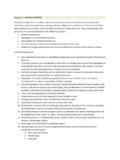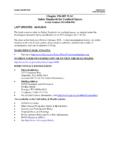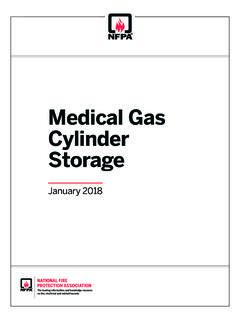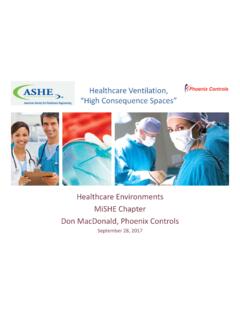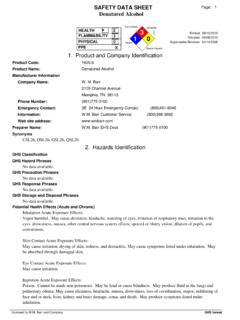Transcription of SUBCHAPTER 7 [705.7] 431 Separation of Direct-Fired ...
1 Title 27 / SUBCHAPTER 7183 SUBCHAPTER 7 SPECIAL USES AND OCCUPANCIESTABLE OF CONTENTS[ or Sec.]* or Sec.** [ ] Art. 1 General[ ]397 Scope[ ]398 Standards[ ]399 Definitions[ ] Art. 2 High Hazard Occupancies[ ]400 Application[ ]401 Explosion Hazard andUnlisted Occupancies[ ]402 Other Requirements[ ]403 Location[ ]404 Sprinkler Requirements[ ]405 Ventilation of StorageOccupancies[ 3 Occupancies Involving Sprayor Dip Finishing[ ]406 Application[ ]407 Classification[ ]408 Location of Processes[ ]409 Construction[ ]410 Ventilation[ ]411 Drying Equipment[ ]412 Sprinklers[ ] Art. 4 Uses and OccupanciesInvolving RadioactiveMaterials and Radiation-Producing Equipment[ ]413 Application[ ]414 City, State, and FederalRegulations[ ]415 Laboratories[ ]416 Radiation Machines[ ]417 Storage[ ] Art.]
2 5 Boiler and Furnace Rooms[ ]418 Application[ ]419 Enclosure[ ]420 Location[ ]421 Clearances[ ]422 Ash Storage Pits and Bins[ ]423 Exit Requirements[ ]424 Ventilation[ ] Art. 6 Dry Cleaning Establishments[ ]425 Application[ ]426 Classification[ ]427 Construction Requirements[ ]428 Ventilation[ ]429 Coin-Operated Units[ ]430 Sprinklers[ ]431 Separation of direct -FiredDryers[ ] Art. 7 Heliports[ ]432 Application[ ]433 Classification[ ]434 Construction[ ]435 Limitations[ ]436 Exits[ ]437 Fire Protection[ ] Art. 8 Automotive Service Stations[ ]438 Application[ ]439 Classification[ ]440 Gasoline and Diesel OilMotor Vehicle Fuel Storage[ ]441 Location of Pumps[ ]442 Heating Equipment[ ] Art. 9 Automotive Repair Shops[ ]443 Application[ ]444 Classification[ ]445 Volatile Flammables[ ]446 Ventilation[ ]447 Sprinklers[ ]448 Heating Equipment[ ]449 Pits[ ] Art.
3 10 Public Garages[ ]450 Application[ ]451 Classification[ ]452 Construction[ ]453 Group 1 Public Garages inBuildings of OtherOccupancy Classification[ ]454 Roof Storage of MotorVehicles[ ]455 Sprinklers[ ]456 Ventilation[ ]457 Exits[ ]458 Ramps[ ]459 Heating Spaces for PeopleHaving PhysicalDisabilities[ ] Art. 11 Open Parking Structures[ ]460 Application[ ]461 Height and AreaLimitations[ ]462 Construction[ ]463 Exterior Walls[ ]464 Curbs and Bumpers[ ]465 Railings[ ]466 Floor Openings[ ]467 Motor Fuel Pumps[ ]468 Mechanical Parking[ ]469 Exits[ ]470 Ramps[ ]471 Elevators[ ]472 StandpipesTitle 27 / SUBCHAPTER Parking Spaces for PeopleHaving Physical Disabilities[ ] Art. 12 Private Garages[ ]473 Application[ ]474 Classification[ ]475 Attached Garages[ ]476 Connection by Breezeway[ ]477 Floors[ ]478 Ventilation[ ] Art.
4 13 Open Parking Lots[ ]479 Application[ ]480 Curb Cuts[ ]481 Protection of AdjoiningProperty[ ]482 Accessory Uses andOccupancies483 Parking Spaces forPeopleHaving PhysicalDisabilities[ ] Art. 15 Swimming Pools[ ]488 Application[ ]489 Construction[ ]490 Dressing Facilities[ ]491 Ventilation and Heating[ ]492 Water Circulation, WaterTreatment, and Drainage[ ]493 Safety for People HavingDisabilities[ ] Art. 16 Radio and Television Towers[ ]494 Application[ ]495 Location and Access[ ]496 Construction[ ]497 Loads[ ] Art. 17 Outdoor Signs and DisplayStructures[ ]498 Application[ ]499 Obstructions[ ]500 Ground Signs[ ]501 Wall Signs[ ]502 Projecting Signs[ ]503 Roof Signs[ ]504 Marquee Signs[ ]505 Illuminated Signs[ ]506 Temporary Signs[ ]507 Use of CombustibleMaterials[ ]508 Maintenance and InspectionArt.
5 17-A Youth Protection AgainstTobacco Advertising andPromotion ProductAdvertisement to of and [ ] Art. 18 Fences[ ]509 Permitted Heights[ ] Art. 19 Tents and Air-SupportedStructures[ ]510 Location and Height[ ]511 Separation [ ]512 Fire Protection[ ]513 Exits[ ]514 StructuralRequirements[ ]515 Flame Resistance[ ]516 Pressurization System[ ]517 Certificate ofOccupancy[ ] Art. 20 Occupancies InvolvingStorage of Nitric Acid[ ]518 Application[ ]519 Location[ ]520 ConstructionRequirements[ ]521 Ventilation[ ] Art. 21 Atriums[ ] [ ] [ ] [ ] ProtectionEquipment[ ] of Egress[ ] Alarm andCommunication System[ ] [ ] Control[ ] Power[ ] Art. 22 Malls[ ] Applicability[ ] Classification[ ] Construction-General[ ] Fire ProtectionEquipment[ ] Egress[ ] Smoke Control[ ] Signs* C26 omitted from section numbers in this column.
6 * 27 omitted from section numbers in this OF TABLEST able Height and Area Limitations of Open ParkingStructures7-2 Ground Signs and Wall Signs (NoncombustibleMaterials)7-3 Roof Signs, Projecting Signs, and Marquee Signs(Noncombustible Materials)7-4 Ground Signs and Wall Signs (CombustibleMaterials)7-5 Roof Signs (Combustible Materials)Title 27 / SUBCHAPTER 7185 ARTICLE 1 GENERAL [ ] 27-397 Scope. This SUBCHAPTER shall apply only to those building types,uses, and occupancies specifically regulated herein, andthe requirements of this SUBCHAPTER shall be in addition tothe general requirements of other subchapters of thiscode governing the size, location, fire protection, means ofegress, construction, and service equipment of plants, packing plants, refineries, and similarspecial occupancies may be constructed in accordancewith the practices and requirements of the particularindustry, subject to the approval of the commissioner.
7 [ ] 27-398 Standards. -The provisions of reference standard RS-7 shall be apart of this SUBCHAPTER . [ ] 27-399 Definitions. -For definitions to be used in the interpretation of thissubchapter, see SUBCHAPTER two of this 2 HIGH HAZARD OCCUPANCIES [ ] 27-400 Application. -This section shall apply to the construction, alteration,and use of buildings or spaces for high hazard occupanciesclassified in occupancy group A under the provisions ofsubchapter three of this chapter. [ ] 27-401 Explosion hazard and Buildings or spaces of high hazardoccupancies that involve explosion hazards or that arenot specifically provided for in this code, shall beconstructed to provide any necessary additional protectionadequate for the hazard involved subject to approval bythe commissioner.
8 [ ] 27-402 Other requirements. -The occupancy and use of high hazard buildings andspaces shall also be subject to the applicablerequirements of chapter four of this title. [ ] 27-403 Location. -High hazard occupancies shall not be located within, orattached to, a building occupied for any other use, unlessseparated from such other use by noncombustibleconstruction having not less than a four hour fireresistance rating. [ ] 27-404 Sprinkler requirements. -Sprinkler protection meeting the construction requirementsof SUBCHAPTER seventeen of this chapter shall be installedin all high hazard occupancies. Where the nature of thefire hazard is such that water is not effective as anextinguishing agent, the extinguishing agent to be used,shall be subject to the approval of the fire commissioner.
9 [ ] 27-405 Ventilation of storage or spaces used for the storage of flammable paints,solvents, anesthetic agents, fuel or other oils having aflash point under two hundred degrees Fahrenheit (Tagclosed cup) or other inflammable vaporous materials shallbe vented to the outdoors by gravity or mechanical means,with independent supply and exhaust openings or ducts. Ifventilation is provided by gravity means, the total netfree openable area of supply and exhaust openings shallbe equal to at least one percent of the floor area of theroom, equally divided between supply and exhaust. Ifventilation is provided by mechanical means, the systemshall be designed to provide at least two air changes perhour. Where there are explosion hazards, see section 27-401 of this article. The construction of all ventilatingsystems shall be in accordance with the requirements ofsubchapter thirteen of this 3 OCCUPANCIES INVOLVING SPRAY ORDIP FINISHING [ ] 27-406 Application.
10 -This section shall apply to the construction, alteration, anduse of buildings or spaces for the spraying, dipping, ordrying of flammable paints, varnishes, and lacquers orother flammable materials, mixtures, or compounds usedfor painting, varnishing, staining, or similar purposes. [ ] 27-407 Classification. -All occupancies involving spray painting, dipping, anddrying with flammable materials shall be classified inhigh hazard occupancy group A. [ ] 27-408 Location of processes. -Spraying, dipping, or drying processes shall be locatedin accordance with the requirements of 27-403 of articletwo of this SUBCHAPTER . [ ]27-409 Construction. -(a) Spray Booths. - Spray booths shall be substantiallyconstructed of noncombustible materials. Panels ofpolished wired glass at least one-quarter inch thick, notexceeding seven hundred twenty square inches in areaand not more than forty-eight inches in any lineardimension, may be used in the sides of spray booths.











